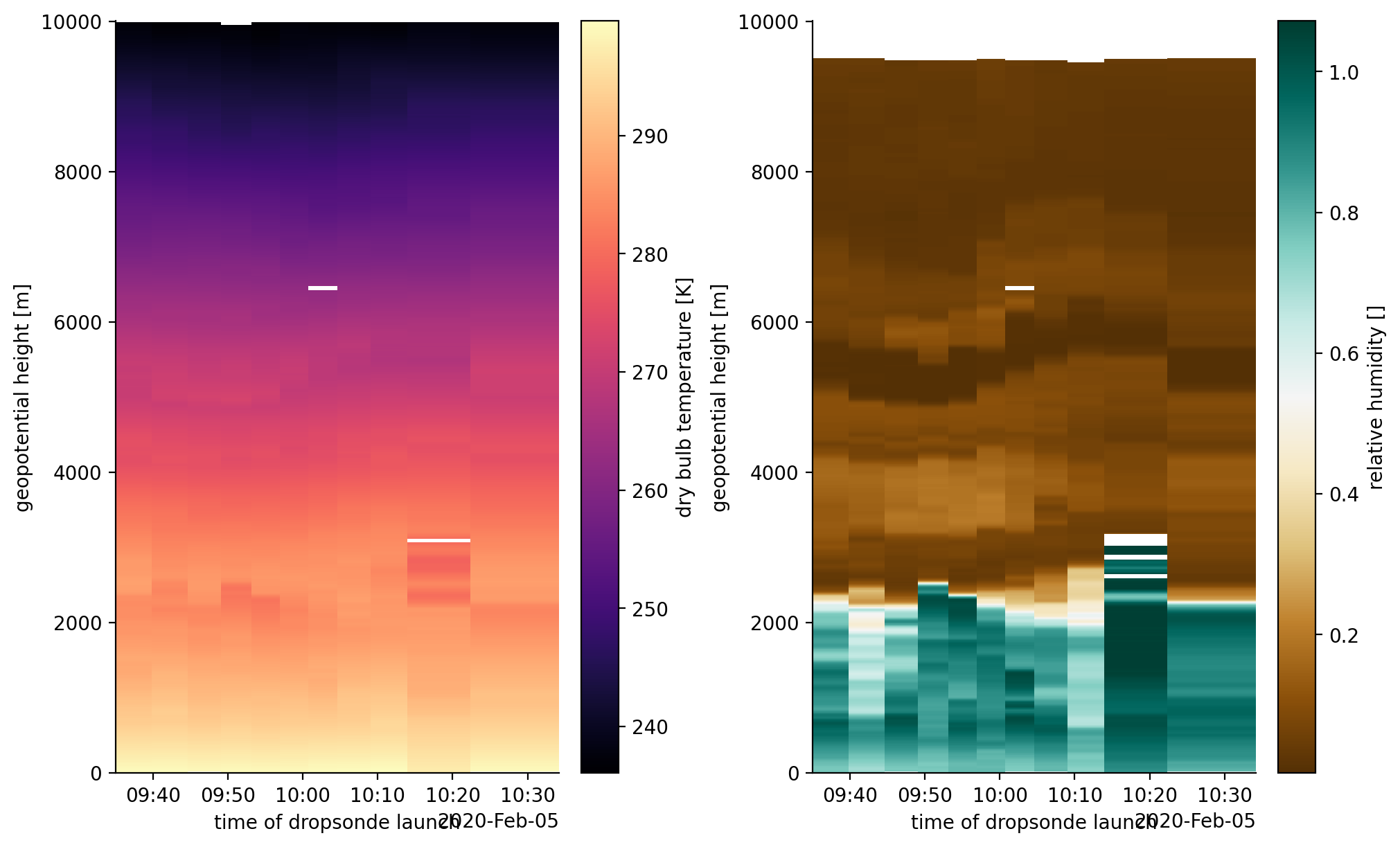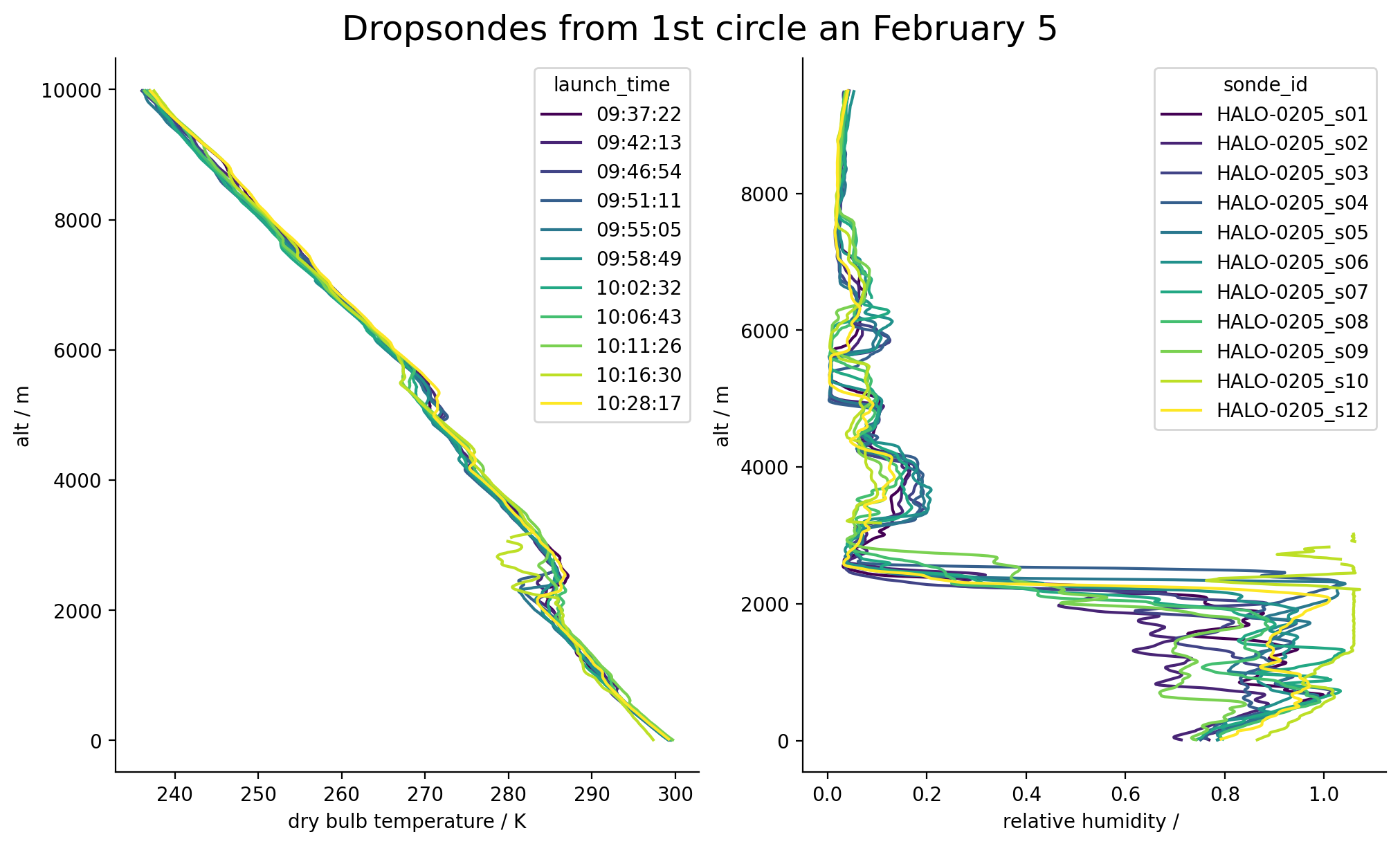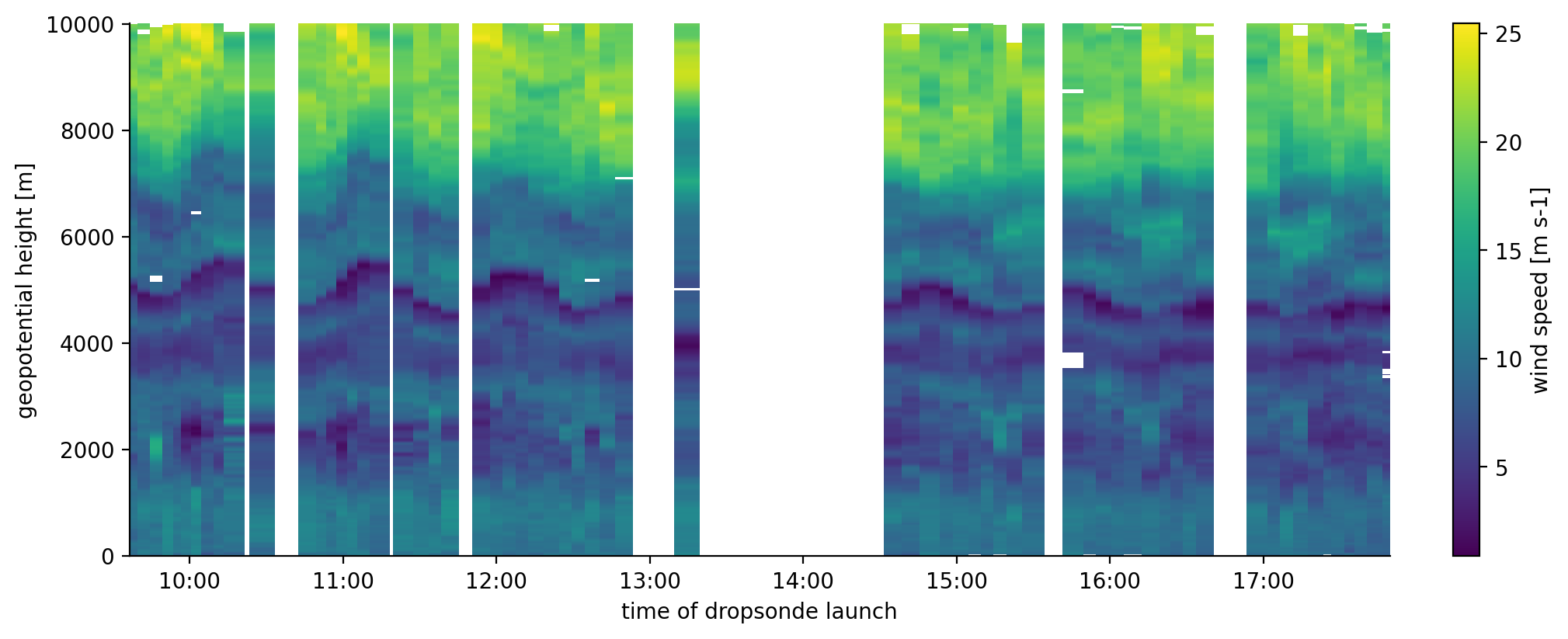Dropsondes dataset JOANNE#
The following script exemplifies the access and usage of dropsonde data measured during EUREC⁴A - ATOMIC.
More information on the dataset can be found in the JOANNE publication describing the dataset.
If you have questions or if you would like to use the data for a publication, please don’t hesitate to get in contact with the dataset authors as stated in the dataset attributes contact and author.
Get data#
To load the data we first load the EUREC⁴A meta data catalogue. More information on the catalog can be found here.
import datetime
import numpy as np
import eurec4a
cat = eurec4a.get_intake_catalog(use_ipfs="QmahMN2wgPauHYkkiTGoG2TpPBmj3p5FoYJAq9uE9iXT9N")
We can funrther specify the platform, instrument, if applicable dataset level or variable name, and pass it on to dask.
Note
Have a look at the attributes of the xarray dataset ds for all relevant information on the dataset, such as author, contact, or citation infromation.
ds = cat.dropsondes.JOANNE.level3.to_dask()
ds
/home/runner/miniconda3/envs/how_to_eurec4a/lib/python3.13/site-packages/intake_xarray/base.py:21: FutureWarning: The return type of `Dataset.dims` will be changed to return a set of dimension names in future, in order to be more consistent with `DataArray.dims`. To access a mapping from dimension names to lengths, please use `Dataset.sizes`.
'dims': dict(self._ds.dims),
<xarray.Dataset> Size: 90MB
Dimensions: (sonde_id: 1068, alt: 1001, nv: 2)
Coordinates:
* alt (alt) int16 2kB 0 10 20 30 40 ... 9970 9980 9990 10000
interpolated_time (sonde_id, alt) datetime64[ns] 9MB dask.array<chunksize=(267, 501), meta=np.ndarray>
lat (sonde_id, alt) float32 4MB dask.array<chunksize=(267, 501), meta=np.ndarray>
launch_time (sonde_id) datetime64[ns] 9kB dask.array<chunksize=(1068,), meta=np.ndarray>
lon (sonde_id, alt) float32 4MB dask.array<chunksize=(267, 501), meta=np.ndarray>
* sonde_id (sonde_id) object 9kB 'HALO-0119_s02' ... 'P3-0211_s43'
Dimensions without coordinates: nv
Data variables: (12/23)
N_gps (sonde_id, alt) float32 4MB dask.array<chunksize=(267, 501), meta=np.ndarray>
N_p (sonde_id, alt) float32 4MB dask.array<chunksize=(267, 501), meta=np.ndarray>
N_rh (sonde_id, alt) float32 4MB dask.array<chunksize=(267, 501), meta=np.ndarray>
N_ta (sonde_id, alt) float32 4MB dask.array<chunksize=(267, 501), meta=np.ndarray>
alt_bnds (alt, nv) int32 8kB dask.array<chunksize=(1001, 2), meta=np.ndarray>
flight_altitude (sonde_id) float32 4kB dask.array<chunksize=(1068,), meta=np.ndarray>
... ...
ta (sonde_id, alt) float32 4MB dask.array<chunksize=(267, 501), meta=np.ndarray>
theta (sonde_id, alt) float32 4MB dask.array<chunksize=(267, 501), meta=np.ndarray>
u (sonde_id, alt) float32 4MB dask.array<chunksize=(267, 501), meta=np.ndarray>
v (sonde_id, alt) float32 4MB dask.array<chunksize=(267, 501), meta=np.ndarray>
wdir (sonde_id, alt) float32 4MB dask.array<chunksize=(267, 501), meta=np.ndarray>
wspd (sonde_id, alt) float32 4MB dask.array<chunksize=(267, 501), meta=np.ndarray>
Attributes: (12/16)
ASPEN_version: BatchAspen v3.4.3
AVAPS_software_version: Version 4.1.2
Conventions: CF-1.8
JOANNE_version: 2.0.0
author: Geet George
author_email: geet.george@mpimet.mpg.de
... ...
featureType: trajectory
instrument_id: Vaisala RD-41
product_id: Level-3
project_id: JOANNE
reference: George et al., JOANNE : Joint dropsonde Observat...
title: EUREC4A JOANNE Level-3Load HALO flight phase information#
All HALO flights were split up into flight phases or segments to allow for a precise selection in time and space of a circle or calibration pattern. For more information have a look at the respective github repository.
meta = eurec4a.get_flight_segments()
segments = [{**s,
"platform_id": platform_id,
"flight_id": flight_id
}
for platform_id, flights in meta.items()
for flight_id, flight in flights.items()
for s in flight["segments"]
]
segments_by_segment_id = {s["segment_id"]: s for s in segments}
segments_ordered_by_start_time = list(sorted(segments, key=lambda s: s["start"]))
We select all dropsondes with the quality flag GOOD from the first circle on February 5.
first_circle_Feb05 = [s["segment_id"]
for s in segments_ordered_by_start_time
if "circle" in s["kinds"]
and s["start"].date() == datetime.date(2020,2,5)
and s["platform_id"] == "HALO"
][0]
first_circle_Feb05
'HALO-0205_c1'
dropsonde_ids = segments_by_segment_id[first_circle_Feb05]["dropsondes"]["GOOD"]
dropsonde_ids
['HALO-0205_s01',
'HALO-0205_s02',
'HALO-0205_s03',
'HALO-0205_s04',
'HALO-0205_s05',
'HALO-0205_s06',
'HALO-0205_s07',
'HALO-0205_s08',
'HALO-0205_s09',
'HALO-0205_s10',
'HALO-0205_s12']
We transfer the information from our flight segment selection to the dropsondes data in the xarray dataset.
from functools import reduce
mask_sondes_first_circle_Feb05 = reduce(lambda a, b: a | b, [ds.sonde_id==d
for d in dropsonde_ids])
ds_sondes_first_circle_Feb05 = ds.isel(sonde_id=mask_sondes_first_circle_Feb05)
Plots#
You can get a list of available variables in the dataset from ds.variables.keys()
Note
fetching the data and displaying it might take a few seconds
%matplotlib inline
import matplotlib.pyplot as plt
import pathlib
plt.style.use(pathlib.Path("./mplstyle/book"))
Temperature and relative humidity as stored in the xarray dataset#
fig, (ax0, ax1) = plt.subplots(1, 2)
ds_sondes_first_circle_Feb05.ta.plot(ax=ax0, cmap="magma", x="launch_time", y="alt")
ds_sondes_first_circle_Feb05.rh.plot(ax=ax1, cmap="BrBG", x="launch_time", y="alt")
None

Temperature and relative humidity profiles.#
The temperature and humidity profiles are colored according to their launch time.
def dt64_to_dt(dt64):
epoch = np.datetime64('1970-01-01T00:00:00')
second = np.timedelta64(1, 's')
timestamp = int((dt64 - epoch) / second)
return datetime.datetime.fromtimestamp(timestamp, datetime.UTC)
fig, (ax0, ax1) = plt.subplots(1, 2)
y = ds_sondes_first_circle_Feb05.alt
x0 = ds_sondes_first_circle_Feb05.ta.transpose("alt", "sonde_id")
ax0.set_prop_cycle(color=plt.cm.viridis(np.linspace(0, 1, len(dropsonde_ids))))
ax0.plot(x0, y.data[:, np.newaxis])
ax0.set_xlabel(f"{x0.long_name} / {x0.units}")
ax0.set_ylabel(f"{y.name} / m")
ax0.legend([dt64_to_dt(d).strftime("%H:%M:%S")
for d in ds_sondes_first_circle_Feb05.launch_time],
title=x0.launch_time.name)
x1 = ds_sondes_first_circle_Feb05.rh.transpose("alt", "sonde_id")
ax1.set_prop_cycle(color=plt.cm.viridis(np.linspace(0, 1, len(dropsonde_ids))))
ax1.plot(x1, y.data[:, np.newaxis])
ax1.set_xlabel(f"{x1.long_name} / {x1.units}")
ax1.set_ylabel(f"{y.name} / m")
ax1.legend(ds_sondes_first_circle_Feb05.sonde_id.values,
title="sonde_id")
fig.suptitle('Dropsondes from 1st circle an February 5', fontsize=18)
None

wind speed variations on HALO circles throughout February 5#
To have a look at the wind speed variations during the circles flown by HALO, we again select the relevant soundings:
mask_sondes_Feb05 = (ds.launch_time.astype("<M8[D]") == np.datetime64("2020-02-05")) & (ds.platform_id == "HALO")
ds_sondes_Feb05 = ds.isel(sonde_id=mask_sondes_Feb05.compute())
We now want to show a time-altitude plot of the soundings. In order to show larger gaps between consecutive soundings,
we first resample the data onto an equidistant grid (along launch_time in stead of sound_id) using nearest-neighbor
interpolation, but limit the maximum difference between sonde launch and interpolated time to 5 minutes. That way,
smaller gaps in the plot are filled while larger gaps are indicated as missing values.
import matplotlib.dates as mdates
with plt.style.context("mplstyle/wide"):
fig, ax = plt.subplots()
ds_sondes_Feb05.wspd.load() \
.swap_dims({"sonde_id": "launch_time"}) \
.resample(launch_time="1min").nearest(np.timedelta64(5, "m")) \
.plot(ax=ax, x="launch_time", y="alt")
ax.xaxis.set_major_formatter(mdates.DateFormatter("%H:%M"))
None



